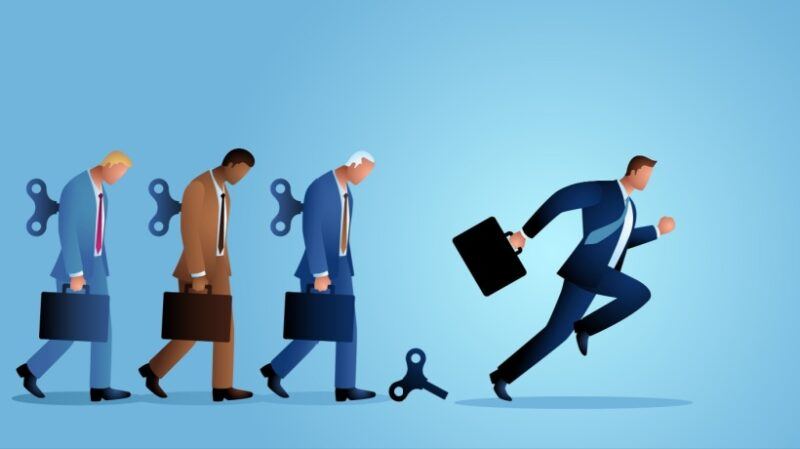

From The Great Resignation To The Great Reshuffle: How Is The Business Landscape Changing?
The large number of people who quit their jobs back in 2021 and 2022 as a result of the pandemic introduced us to an unprecedented phenomenon known as the Great Resignation. Millions left their jobs to protect their health, prioritize their families, or pursue a better work-life balance. However, later data has shown us that there was more to this decision. A survey from the Pew Research Center revealed that following the Great Resignation, 53% of the people who resigned have transitioned into entirely new fields of work. Therefore, what we are witnessing is the next phase for employees, named “the Great Reshuffle.” In this article, we will explore what this phenomenon involves and how it is affecting the labor market.
What Is The Great Reshuffle?
Let’s begin by saying that the Great Reshuffle and Great Resignation are not two separate phenomena in the job market, but rather one is the result of the other. Specifically, what began as individuals quitting their jobs due to unsafe, overwhelming, or toxic work environments turned into a complete reevaluation of their lives and priorities. People have stopped looking for jobs that would simply pay the bills. Now, they are looking for positions that bring fulfillment by aligning more closely with their long-term career goals and supporting a better work-life balance. This way, many employees completely shifted from their current line of work, changing industries or opening their own businesses, leading to a “reshuffling” of the labor market.
There are many reasons behind the Great Reshuffle. One can say that it was even inevitable, and the drastic changes brought about by the pandemic merely accelerated it. The ability to work remotely or simply spend more time at home during this time made people recognize the advantages of flexible work conditions. At the same time, employees in labor-intensive industries, such as hospitality, retail, and healthcare, faced an unprecedented level of burnout, leaving them questioning whether they wanted to continue in such career paths. As a result, workers started looking for jobs that better aligned with their goals and values, especially as younger generations, i.e., millennials and Gen Z, started making up a larger portion of the workforce.
How Is The Job Market Changing?
The Great Reshuffle is changing the labor market in many ways, some positive and some negative.
1. Talent Shortage In Certain Industries
Given the shift in priorities and mentalities among employees, many are leaving their positions in demanding industries, such as healthcare, hospitality, education, and manufacturing. They are in search of better pay, improved working conditions, and a healthier work-life balance. This is causing a talent shortage in these sectors, as the experienced and knowledgeable workers who leave are not easy to replace with new hires.
2. Increased Leverage For Employees
While these talent shortages may be impacting quite a few industries, they have also given employees greater negotiating power than they ever had. Since employers are struggling to find replacements for vacant positions, they are more likely to accommodate employee requests. This translates to higher salaries, improved benefits, performance bonuses, and more, depending on the sector.
3. Rise Of Flexibility In The Work Environment
Another positive impact of the Great Reshuffle is that it has encouraged employers to prioritize flexible work conditions. This is not only because they want to accommodate candidates’ preferences but also because businesses that offer flexible work hours have observed higher employee engagement and overall productivity. Additionally, the rise in remote work has enabled businesses to tap into a global talent pool, helping them overcome limited local talent.
4. Experience Vs. Education
The traditional concept of a candidate holding specific degrees for a company to consider them is no longer so strict. This shift is understandable, given the speed with which industries are transforming nowadays. What is more important to employers and recruiters is that potential hires possess the necessary skills, even if they come from previous experience, online courses, or certifications. This allows non-traditional candidates who may be self-taught or have attended seminars to transition into new careers.
What Should Business Leaders Prioritize During The Great Reshuffle?
The Great Reshuffle can increase employee turnover rates within your organization and impact its efficiency. Therefore, it is important that you take a few steps to protect your organization and support your workforce.
1. Employee Wellness
The Great Resignation, and subsequently the Great Reshuffle, came as a result of employees experiencing burnout and an unhealthy work-life balance. Therefore, it only makes sense to combat that by implementing a comprehensive employee wellness program. This will ensure employees are getting the support they need to stay healthy, protect their mental well-being, and set boundaries between their personal and professional lives. Most importantly, they will feel appreciated and forge a more meaningful connection with the company.
2. Reskilling And Upskilling
Helping employees acquire new skills to improve in their current position or transition to another, also known as upskilling and reskilling, is key in the era of the Great Reshuffle. If employees are seeking a change in their daily routines or overall careers, business leaders can make that happen for them. With mentorship programs, training courses, certifications, etc., you can help employees enrich their skillsets to take on more responsibilities, advance to a higher level, or transition to a new position within the company. This way, you retain valuable talent, and employees don’t have to search for new jobs from scratch.
3. Open Communication
A guaranteed way to lose employees is to create a work environment that discourages open communication. If employees feel like they can’t share their frustrations and share their thoughts, they are likely to grow frustrated and seek other opportunities. Therefore, it is essential that you maintain open lines of communication with your employees, engaging in regular dialogue and conducting surveys periodically to gauge their satisfaction and engagement levels. This way, you will be able to detect any early warning signs of frustration and take the necessary measures to reconnect with your employees.
4. Flexible Work
As we mentioned earlier, one of the reasons behind the Great Reshuffle is that employees discovered the numerous benefits of remote work. Consequently, if you haven’t already, you should certainly consider implementing flexible work arrangements, such as hybrid work or work-from-home options. If that’s not possible for your industry, you can still explore alternatives like flexible work hours, compressed workweeks, and shift swapping, among others. This way, employees will feel more in control of their everyday schedule and more capable of achieving a satisfactory work-life balance.
Building Future-Ready Businesses Through The Great Reshuffle
We are not sure how long the Great Reshuffle might last. Besides, there always were and always will be people who have the desire to completely change careers at one point in their lives or another. But what we do know is that its effects on the labor market are here to stay. This trend has shifted the focus of business leaders toward employee skill development and well-being, transforming leadership and management styles. And, it seems that this is ultimately for the better. Companies that recognize workplace trends and take measures to adapt will be better equipped to navigate future changes and challenges, setting themselves up for success.
Source link




